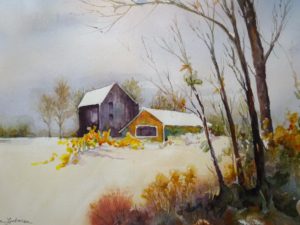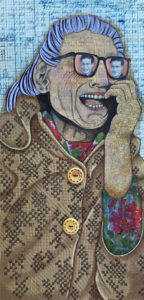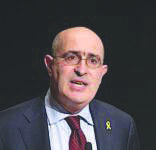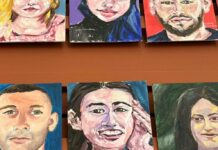
For the first time in almost three years, Congregation Beth Or will reopen its Olitsky Art Gallery, a symbol of the reconvening of the Beth Or community in the Jewish New Year.
The gallery, which opens on Oct. 14 after Friday night Shabbat services, will display the works of two local artists: Karen Liebman, who has operated the gallery for the past seven years, and Cyndi Philkill, a non-Jewish mixed media collagist.
In past years, gallery openings coincided with onegs held after Shabbat services as a way to schmooze with the visiting artist and other congregants. After three years of online and hybrid services, the reopening of the gallery following in-person High Holiday services will mark the return of an opportunity to build community.
“I definitely wanted it to follow Yom Kippur because that would get people used to coming back again — we’re so happy to see people finally coming back again,” Liebman said.
Liebman and Philkill’s contrasting styles will be put in conversation with one another, with Liebman favoring watercolor and acrylic landscapes and Philkill depicting a series of portraits constructed out of paper, paint and other materials.
“My work is basically based on my travels,” Liebman said.
Though she has 15 years of experience in painting to her name, Liebman’s art philosophy is that she always has more to learn. This will be the second time in the gallery’s 33 years that Liebman will display her works.
Also a seasoned artist, Philkill combines more traditional mediums, such as oil pastels, with found objects. For the past several years, she’s created collage portraits based on hospice patients she visited as a hospice volunteer coordinator.
“I became very interested in trying to capture older adults and people that were in their lives,” Philkill said. “And not in a morbid sense, but in a sense that I wanted to bring attention to the fact that they are so vibrant, they still have dreams and hopes and passion and wisdom in their lives.”
Philkill describes her art as “representational” but not abstract. Her mixed media collages aren’t of specific people but rather a patchwork of personality traits and interests.
With Liebman’s pieces contrasted with hers in the gallery, Philkill has already found ways to interpret her pieces with new meaning. She considers both the works to be landscapes, though Philkill calls her pieces “people landscapes.”
Both works are “puzzle-like,” combining different planes or components to create a coherent image, Philkill said.
The two artists only began to understand the similarities of their works after deciding to combine them for the gallery opening.
“That’s the beauty and the power of art: to create community, to start discussion,” Philkill said. “And we’re both really hoping this exhibit will facilitate that here at Beth Or.”
Liebman and Philkill met through ARTsisters, a Philadelphia-based collective of women artists founded 12 years ago. About 25 members meet monthly to provide feedback and support to the cohort.
“Sometimes, as women and as artists, we can feel a little alone and isolated,” Philkill said. “That sometimes it’s harder to get recognized and find venues to exhibit.”

Beth Or’s Olitsky Gallery has become a similar outlet for artists to find an audience.
In 1989, Beth Or member Norma Jarrett approached the then-new Rabbi Gregory Marx about creating an art space at the synagogue.
“You need patronage in order to get into an art gallery; you need money for an art gallery,” Marx said. “And Norma said, ‘We have this space. Let’s show people’s work, both from the local community and beyond.’”
The gallery became a way to both support local artists and bolster synagogue attendance. On Friday nights after Kabbalat Shabbat services, Beth Or held gallery openings; the synagogue attracted both new congregants and art lovers. A designated gallery space even survived the synagogue’s move from Spring House to Maple Glen in 2006.
In March 2020, the gallery, like the synagogue, stopped receiving visitors. The once-vibrant art space mirrored the emptiness of the synagogue sanctuary and most other buildings at the onset of the pandemic.
“We had this beautiful space with bare walls and wires hanging down where they used to be pictures. It almost looked like an empty warehouse … it looked schwach,” Marx said. “The building was empty; there was no art.”
As Beth Or resumes their tradition of mingling art and religion, Marx hopes the gallery will once again be a microcosm of synagogue life, this time vibrant and reinvigorated.
“What does it mean to me?” Marx said. “The return to life and beauty and celebration of art, hopefully bringing people in and sharing not only in the sacredness of time but also in the beauty of space.”






